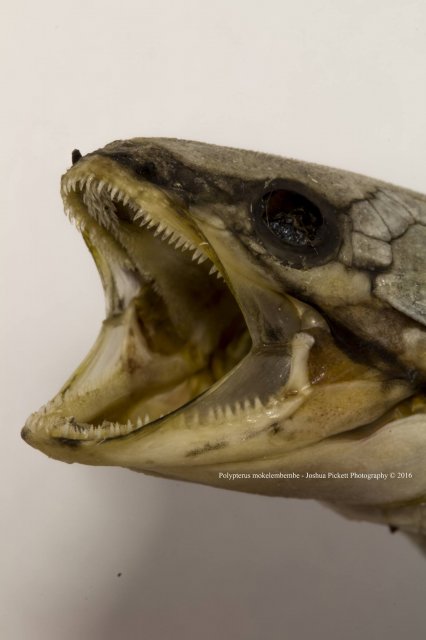I get a lot of specimens donated to me from shops and other hobbyists as I like to preserve and display them. This method only works with armoured fish, such as Polypterids, Gars and Bowfin.
The reason why I do this is because I get to find out how a fish has died, I learn about their anatomy and they make great displays for a fish someone has been raising for a long time with personal attachment or if they just think they're visually appealing.
During dissection of some specimens, I've found some interesting causes of death; gravel lodged throughout their digestive tract, sand compacted in their stomach, swollen pellets and oily coatings lining the inside of their lungs which had suffocated them. (from feeding oily foods which slick the water surface)
For an in-depth How To, please watch this video
Toothpick holding the mouth open of a specimen just after boiling.

Conicle tooth patches of a P. mokelembembe. (below)


One of the smaller mounts (below)



(below) The P. bichir lapradei which was the first to successfully breed in the UK. She bred with a P. ornatipinnis.
Sadly she died from a speculated infection and oil-lined lines.
JT-AQUARIUN had this picture of her tattooed!


The idea for these mounts were inspired by King-El's. I'm still practicing to get the quality of mine on par with his haha.
If you've preserved any specimens, post below! I'd love to know your methods
(I have some wet specimens and other mounted ones, I'll post below once I've taken some more pictures)
The reason why I do this is because I get to find out how a fish has died, I learn about their anatomy and they make great displays for a fish someone has been raising for a long time with personal attachment or if they just think they're visually appealing.
During dissection of some specimens, I've found some interesting causes of death; gravel lodged throughout their digestive tract, sand compacted in their stomach, swollen pellets and oily coatings lining the inside of their lungs which had suffocated them. (from feeding oily foods which slick the water surface)
For an in-depth How To, please watch this video
Toothpick holding the mouth open of a specimen just after boiling.

Conicle tooth patches of a P. mokelembembe. (below)


One of the smaller mounts (below)



(below) The P. bichir lapradei which was the first to successfully breed in the UK. She bred with a P. ornatipinnis.
Sadly she died from a speculated infection and oil-lined lines.
JT-AQUARIUN had this picture of her tattooed!


The idea for these mounts were inspired by King-El's. I'm still practicing to get the quality of mine on par with his haha.
If you've preserved any specimens, post below! I'd love to know your methods
(I have some wet specimens and other mounted ones, I'll post below once I've taken some more pictures)











